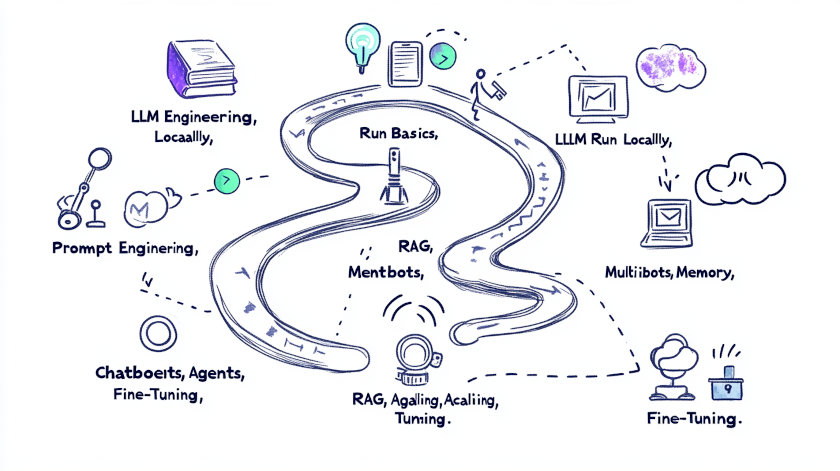
LLM Learning Roadmap for software developers
Stage-by-stage roadmap to mastering LLM technology, from foundational concepts to advanced, production-ready solutions
Large Language Models (LLMs) are transforming the landscape of software engineering, powering intelligent chatbots, retrieval-augmented systems, and autonomous agents. For developers aiming to harness these capabilities using modern frameworks like Spring AI, PGVector, and Ollama, a structured learning path is essential. This article presents a comprehensive, stage-by-stage roadmap to mastering LLM technology, from foundational concepts to advanced, production-ready solutions.
1. Grasping LLM Fundamentals
Understanding the Architecture
Begin by exploring the theoretical underpinnings of LLMs:
- Learn the distinctions between transformer architectures: encoders, decoders, and sequence-to-sequence models.
- Study tokenization-the process of converting text into numerical representations.
- Dive into attention mechanisms and their role in contextual understanding.
- Understand decoding strategies, including prefill and decode phases of inference.
Practical Exploration
- Use visualization tools to observe LLM internals.
- Enroll in foundational LLM courses, such as those offered by Hugging Face.
- ✅ Open AI API
2. Running LLMs Locally with Ollama
Installation and Setup
- Download and install Ollama, a platform for running LLMs locally.
- Familiarize yourself with basic command-line operations.
Model Deployment and Optimization
- Launch your first model (e.g., Qwen 3 8B) and assess hardware requirements.
- Experiment with quantization (such as GGUF format) to optimize for speed and resource usage.
- Adjust launch parameters to balance quality and performance.
3. Prompt Engineering and Tuning
Building Effective Prompts
- Master the principles of prompt engineering for clear, actionable queries.
- Learn to structure prompts by separating instructions, context, and questions.
Iterative Improvement
- Test and refine prompts based on model responses.
- Develop a library of prompts tailored to various tasks and evaluate their effectiveness.
4. Building RESTful Chatbots with Spring AI
Spring AI Integration
- Set up a Spring Boot project and integrate Spring AI dependencies.
- Configure connections to local LLMs via Ollama’s API.
API Development
- Implement REST controllers for chatbot interactions.
- Design a service layer to handle LLM communication.
- Test endpoints using tools like Postman or a simple frontend.
5. Implementing Chat Memory
Conversation History Management
- Design data structures and set up a PostgreSQL database for storing chat histories.
- Integrate message history into LLM queries to maintain conversational context.
- Develop strategies to manage context window limitations efficiently.
6. Enabling Retrieval-Augmented Generation (RAG)
Vector Database Integration
- Install PostgreSQL with the PGVector extension for vector storage.
- Create tables and indexes for embedding storage and similarity search.
Embedding and Retrieval
- Use Spring AI’s EmbeddingClient to generate document embeddings.
- Implement logic to retrieve relevant documents based on vector similarity and inject them into model prompts.
- Optimize retrieval with advanced indexing techniques like HNSW.
7. Expanding with Tools and Agents
Function Calling and Tool Integration
- Enable LLMs to invoke Java functions through structured prompts.
- Design agents capable of selecting and using tools based on user intent.
Agent Architecture
- Develop decision-making mechanisms and test agents on real tasks.
- Optimize agent workflows for accuracy and efficiency.
8. Orchestrating Multi-Agent and Multi-Chain Processing
Complex Workflow Design
- Build architectures for sequential and parallel processing chains.
- Implement protocols for agent-to-agent communication and coordination.
Scenario Testing
- Simulate multi-agent collaboration on complex tasks and refine system performance.
9. Connecting External Services and Scaling
API and Cloud Integration
- Connect to external APIs (OpenAI, cloud LLMs) and design abstractions for model switching.
- Expand capabilities to support multimodal inputs (images, audio) and additional external services.
Performance and Scalability
- Implement caching and load balancing strategies.
- Architect the system for horizontal scaling and high availability.
10. Fine-Tuning LLMs for Custom Needs
Data Preparation and Training
- Collect and preprocess datasets for domain-specific fine-tuning.
- Split data into training and validation sets.
Parameter-Efficient Fine-Tuning
- Apply techniques like LoRA and QLoRA to fine-tune models efficiently.
- Tune hyperparameters and evaluate model performance iteratively.
Learning Resources and Practical Projects
Recommended Resources
- Hugging Face courses on LLMs and agents
- Spring AI and Ollama documentation
- Tutorials on RAG, PGVector, and vector databases
Hands-On Projects
- Local chatbot with prompt understanding
- REST API for LLM interaction
- Chatbot with persistent memory
- RAG-based Q&A system
- Tool-using agents
- Multi-agent orchestration
- Fine-tuned, domain-specific LLMs
- Full-featured assistants integrating multiple data sources
Conclusion
This roadmap provides a clear, actionable path for software developers to master LLM technologies using state-of-the-art frameworks. By progressing through these stages and consolidating knowledge with practical projects, developers can build robust, scalable, and intelligent AI applications tailored to real-world needs.
Useful materials
Authors:
- Sinan Ozdemir - AI and LLM Expert, Author, Educator
- Paulo Dichone - Software Engineer, AWS Cloud Practitioner & Instructor
- Rob Barton & Jerome Henry - Experts in AI & ML Tools for Deep Learning, LLMs, and More
- Ken Kousen - Integrating AI in Java Projects
- Arnold Oberleiter - A passionate lecturer in the field of Artificial Intelligence.
Published on 12/20/2024